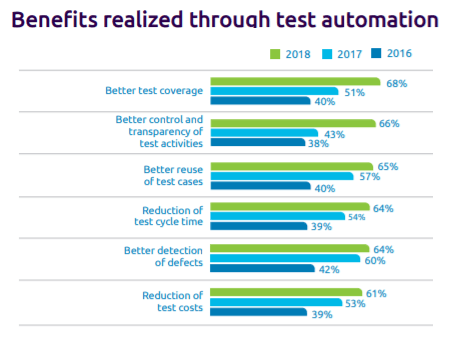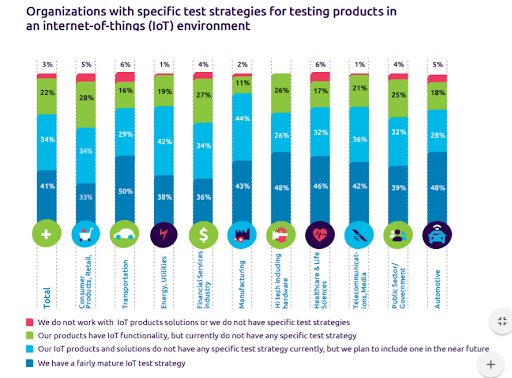13 Software Testing Trends To Look Out For In 2020
Technology is constantly evolving, what was state of art a few years back might be defunct now. Especially now, where the world of software development and testing is innovating ways to incorporate emerging technologies such as artificial intelligence, machine learning, big data, etc.
Be it selenium test automation, browser compatibility testing, or any other form of testing methodology; each of these testing methodologies is constantly transforming with the vision to deliver better products. There may not be a better time to be a software tester by profession than now. However, that is only possible if one is aware of what is trending in the testing domain. If you are a software tester, it becomes imperative to realize the top software testing trends in the industry. If you are not able to catch up to what’s up and trending, here is an article that compiles a list of top 13 software testing trends to look out for in 2020.
1. Test Automation
As per a report, the overall global automation testing market size is expected to grow from $12.6 billion in 2019 to $28.8 billion by 2024. The growth is staggering at the Compound Annual Growth Rate (CAGR) of 18% during the forecast period. Increasing the adoption of DevOps and Agile are some of the key factors driving the growth of the automation testing market.
Agile development, continuous testing, CI/CD implementation, and DevOps are helping software organizations in enabling frequent code deployments and realizing the goal of reliable software delivery. Test automation is an integral part of each of these processes as it reduces the dependency on manual testing, especially for tasks that are repetitive or do not require any manual intervention.
For example, organizations have been making use of Selenium test automation to realize their goals for cross browser testing. Selenium test automation not only helps in improving the test coverage but is also considered to be more scalable & economical when compared to setting up a local test infrastructure.
Technologies like AI, ML, NLP, etc. will be extensively used in the development of test automation tools as they can aid completely autonomous test creation, ease page object identification, ease the process of DOM analysis, and more. Though test automation has been in use for more than a decade, advanced technologies will up the game of test automation in 2020.
2. Testing focused on Progressive Web Apps
Introduction of Progressive Web Apps (PWA) by Google marked the dawn of a new era in mobile app development. With PWA, you don’t need to download and install the app on the mobile phone, rather a web application (app) that makes use of modern web capabilities to deliver a web-like experience to the end-users. As per many case studies, PWA’s have resulted in better user engagement, new user conversions, etc. for companies like Twitter, AliExpress, and more.
Although one thing is to be noted that progressive web apps rely a lot on the features of modern web browsers. Thus, it becomes necessary to ensure the functionality of the web app on older browsers. Online cross browser testing cloud such as LambdaTest can help you quickly test your PWA over 2000+ real browsers for both mobile and desktop.
Tips For Testing A Progressive Web Application
As per a report by Gartner, Progressive Web Apps (PWA) will gain more prominence in 2020, with PWAs replacing 50% of the consumer-facing apps. This also puts the focus back on mobile testing tools & selenium automation testing frameworks as those tools have to be enhanced for testing the features in PWAs.
3. Artificial Intelligence and Machine Learning
Artificial Intelligence (AI) will be ubiquitously present across all departments of technology. As per a report, the market is expected to reach $190.6 billion by 2025 from $21.5 billion in 2018, at a Compound Annual Growth Rate (CAGR) of 36.6% during the forecast period. AI is considered the future of automation testing and will play a big role in data mining/creation in the future.
The lethal combination of AI and Machine Learning (ML) will be used more extensively for making automation testing better. It will accelerate the process of test automation, including cross browser testing. Moreover, AI & ML will act as a catalyst to revolutionize the automation testing industry in 2020.
AI and ML will become an integral part of test creation and test execution. This will not only require a mindset shift but the skill sets shift that will be the key to automation testing. This also means that QA tools used for Selenium automation testing and cross browser testing will have to evolve over a period of time. QA tools based on AI/ML technologies will speed up UI/GUI testing for websites/web applications. These tools will also enable patterns and visual validation.
ML algorithms in conjunction with image recognition and pattern recognition algorithms will accelerate the testing of UI interfaces. More QA tools in 2020 will also have the capability to self-healing and self-script test cases/test suites.
Increased usage of AI and ML in tasks related to software quality assurance/automated testing will be one of the key software testing trends in 2020.
4. Focus on Shift-Left Testing & Continuous Deployment
Large corporations, including early-stage startups, are making increasing use of DevOps and shift-left testing to gather continuous feedback & incorporating the feedback in the product release. Continuous Deployment (CD) uses selenium automation testing to validate the changes in the codebase and deploying the stable release to the production environment. With shift-left testing, the QA team does not work in a silo but works in tight coordination with the development and product teams.
Organizations have realized the immense potential of DevOps and continuous deployment of product testing and delivery. In 2020, there will be more focus on automation, cloud based testing, cross browser testing, etc. as DevOps will morph into continuous deployment. QA teams will co-work with the operations team to ensure timely ‘quality product’ releases making the entire software release process more seamless and integrated.
The transition of DevOps to Continuous Deployment improved focus on shift-left testing, and growing prominence of QAOps is the software testing trends that will shape the era of automation testing in 2020.
5. QAOps
In today’s competitive business environment, it becomes critical that there is no deterioration of quality between software releases else it could delay the final customer release. The role of the QA team is no longer limited only to testing but QA is involved in every aspect of software development. DevOps is another critical automation process that is vital to every product/feature release as it enables quicker deployment of changes in the production build.
QAOps or DevTestOps is a practice that brings the developers, testers, and operation engineers on the same page by blurring the boundaries between them. In QAOps, continuous testing is combined with DevOps to ensure that software changes go into production phase with the Continuous Integration (CI)/Continuous Deployment(CD) pipeline rather than performing software testing at indefinite intervals without quality issues and any delays.
What Is QAOps? And Why It Matters For Your Web Application?
Automation test tools including Selenium automation testing will also play a major role in QAOps as they accelerate the process of selenium automation testing. Though organizations have been making use of QAOps for close to a decade, it is expected to be one of the major software testing trends of 2020.
6. Spidering AI
AI/ML is already considered an integral part of automation testing. AI Spidering takes AI in automation testing notch above as it enables automation in the test script writing procedure. AI Spidering makes use of advanced ML algorithms to crawl the application when you are busy working on the project.
Automation tools that use AI Spidering collect important data about the features being used in the application e.g. recording videos of test scenarios, taking screenshots, measuring execution time, etc. These steps are repeated numerous times and the data is used to train the ML models regarding the working patterns.
Automation tool built on AI Spidering than compares the current working pattern with the data which is a part of the ML model. Any deviation e.g. slower speed of execution, issues with implementation, problems with GUI/UI are flagged as potential problems and these details are added in the end report.
AI Spidering is extremely useful for developers & testers as it gives information about which parts of the application worked and which did not. This will help to focus on a section of code/implementation which was flagged as a ‘potential issue’ by the tool. When there is a discussion on AI in automation testing/Selenium automation testing, AI Spidering will be one of the talked about software testing trends for 2020.
7. Mobile Test Automation
The global smartphone shipments reached a mammoth 380 million units in Q3, 2019. Though the growth remained flat when compared to 379.8 million units shipped in Q3 2018, the year witnessed the launch of smartphones in new form factors. The best examples are foldable phones and low-cost feature phones with KaiOS. The global foldable phone market is expected to grow at a Compound Annual Growth rate (CAGR) of 24.6% from 2019 to 2025.
As mobile phones are becoming more capable & powerful, global mobile app development is also showing phenomenal growth, expected to generate a market value of $14 billion by 2023 growing at a CAGR of 22% during the period 2018-2023. This makes mobile app testing extremely important as apps have to be tested across different sets of devices and operating systems.
The trend for automated testing for mobile apps is on a rise, primarily driven by shorter time-to-market and requirement for advanced methodologies for mobile test automation. Though popular automation testing tools for mobile apps like Appium are used in the DevOps process, the present utilization of test automation tools for app testing is not encouraging.
In 2020, we expect tighter integration between mobile device labs and testing tools as it is a pressing need looking at the growth of the mobile app market.
8. Multi-Device Testing
Increased penetration of mobile devices/smartphones and the introduction of a wide range of IoT devices has made multi-device more prominent than ever before. Consumers now have the option to access ‘nearly the same set of information’ from smartphones, smart speakers, wearables, or other types of IoT/connected devices.
In 2020, automation testing teams will have the responsibility of executing automation tests on a range of devices, including smart home appliances. Cross browser testing and Selenium Automation Testing will also take center stage as multi-device and multi-platform testing remains one of the software testing trends of 2020.
9. Internet of Things (IoT) Test Automation
Internet of Things (IoT) is considered one of the most trending technologies in today’s times and with the evolution of 5G & other emerging networking technologies, IoT will gain more prominence in the future. As per a Gartner report, there could be more than 20 times as many smart devices at the edge of the network as in the conventional IT roles.
IoT (and IIoT) is in use across different industries – embedded systems, manufacturing, government sector, consumer electronics, and more. The data that is generated by the connected can help businesses gain critical insights and take appropriate actions to run the business efficiently. IoT and IIoT (Industrial Internet of Things) will play a much bigger role in 2020 and this includes IoT application testing.
IoT application testing will gain prominence in 2020 as it has a significant number of benefits including improved test coverage, defect prevention at early stages of product development, accelerated automated testing, and reduced time to market.
With more and devices becoming connected, IoT application testing will be one of the key software testing trends that will have a positive impact on different industries.
10. Selenium 4
When we talk about consumer web products (websites/web applications), cross browser testing plays a very important role as far as selenium automation testing is concerned. The product has to be tested against different combinations of web browsers, operating systems, and devices. Selenium, the open-source web framework is used widely for automation testing and Selenium automation testing will thrive further in 2020.
A couple of months back, Selenium 4 (alpha) was released and there has been a major excitement around Selenium 4 even when it was announced. Selenium 4 has a number of new features and enhancements that will make cross browser testing & automation testing more delightful. Selenium 4 has new commands for accessing the Selenium Grid, docker support, and much more. New features such as relative locators, open-source Chromium driver support for Edge Browser, etc. would further cement the position of the Selenium framework as the go-to framework for automation testing.
What To Expect From The New Version Of Selenium 4 Alpha?
With continuous testing becoming a business imperative and selenium test automation becoming a part of the delivery, it is essential to have a cultural and mindset shift within the QA team. More software enterprises are embracing the Selenium framework for test automation and the expected release of Selenium 4 will be one of the defining software testing trends of 2020.
11. Voice Assisted Technology
2019 witnessed the release of many smart speakers with voice-assisted technology. Not only smart speakers, but voice-assisted technology is also now a part of many mobile phones and homes. You no longer need to press a key to wake-up a device as it can all be done using the appropriate wakeup commands (phrases).
With wider adoption, companies are investing heavily in improving the various aspects related to voice technology i.e. dialect, personalization, removal of ambient noise from voice samples, etc. While voice technology is more prominent in smart speakers, not many mobile applications have voice command features. Issues related to privacy and accuracy could be one of the factors that could stagnate the growth of voice-assisted technology.
According to Google, at present 27 % of the overall global online population is utilizing voice search on mobile. Testing voice technology is tricky and automation testing frameworks need to accommodate ‘voice’ in their roadmap. Test automation frameworks will have to evolve to factor the testing of voice commands and we will see many of these expectations turning into reality in 2020.
12. Big Data Testing
With the emergence of big data, businesses across different industries have huge amounts of data that is utilized to make informed business decisions. Irrespective of whether the data is structured or unstructured, the quality of big data matters a lot. Along with the quality of data, functional testing and performance testing are important components of big data testing.
According to the World Economic Forum, 44 zettabytes of data will be produced by 2020. Big data testing will be one of the biggest software testing trends in 2020 as the digital transformation will drive companies towards real-time data analysis and decision-making at a massive scale.
13. Robotic Process Automation (RPA)
Robotic Process Automation is considered a subset of AI. It is used in sectors like banking, finance, etc. to automate software jobs that are mundane in nature and do not require any manual intervention. This is done by configuring software ‘robots’ that capture data and perform those routine tasks. The spending on RPA tools is expected to reach $1 billion by 2020 with the growth occurring at CAGR of 41%.
RPA software is now being used across different industries and it is increasingly moving beyond task & process automation. It is visualized as a tool for business transformation. According to Gartner, RPA was considered the fastest-growing enterprise software category last year and it will continue its rapid growth in 2020.
The rapid growth of RPA can be attributed to the power of process automation that can be applied to legacy systems/processes in organizations. Robotic Process Automation falls in the category of software testing trends that will redefine process automation for a range of industries.
Wrapping it up

As per our experience & foresight, these were some of the software testing trends that will dominate 2020. One thing is given that selenium automation testing will be one of the key focus areas for organizations that are into the development of consumer-facing websites/web applications. Advancements around mobile testing and tools that enable the testing of apps/PWAs will be one of the areas that will be eagerly watched by many of us.
AI/ML will also play a major role in feature enhancements of tools that perform automated browser testing and Selenium automation testing as they are expected to ease the job of testers as far as test case creation & maintenance is concerned. There will also be a surge of codeless automation tools enabling testers to do much more in the field of automation testing.
These were some of the software testing trends for 2020; do share your thoughts on the upcoming trends that will define the year 2020!
Published on Java Code Geeks with permission by Himanshu Sheth, partner at our JCG program. See the original article here: 13 Software Testing Trends To Look Out For In 2020 Opinions expressed by Java Code Geeks contributors are their own. |






